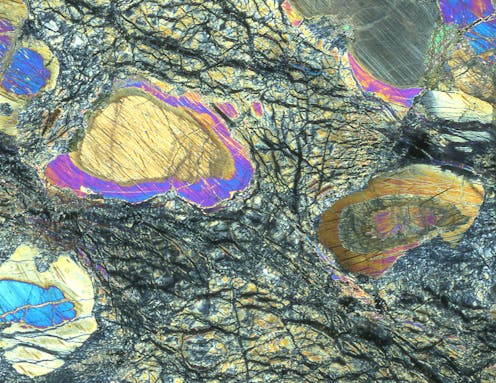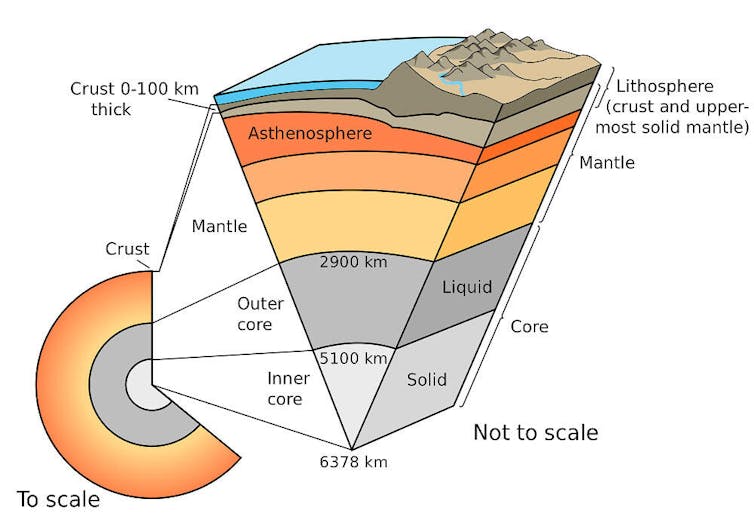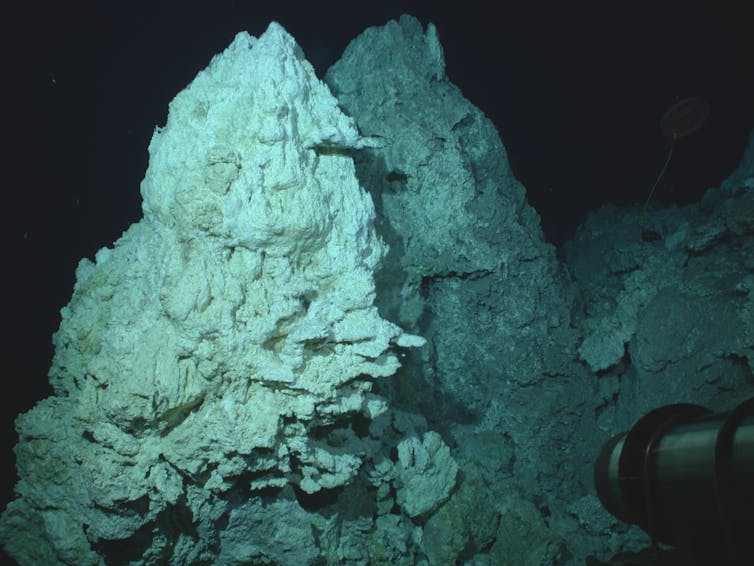
If you were to slice through it, you would see the Earth is divided into distinct layers. On top is the relatively thin crust where we live. Beneath that is the 2,900 km thick mantle layer. Then, enclosed within the mantle is the innermost metallic core of our planet.
The mantle is Earth’s largest layer of rocks. However, because it is covered by at least six kilometres of crust, drilling into it has not generally been possible. The only exception has been where the mantle is exposed by faulting, where a crack forms in the Earth’s crust.
I was part of an international team which retrieved a record-breaking 1,268m-long drill core (a long cylindrical sample of rock collected by the drill) of mantle rock from the seabed. This sample, which is more than six times longer than the previous core of mantle rock, has given us a glimpse into the composition of this mostly inaccessible layer of the Earth. You can read full details in the journal Science.
The types of rock we retrieved are known as abyssal peridotites – the primary rocks of Earth’s upper mantle. We collected the core from a zone called the Mid-Atlantic Ridge on the seafloor under the North Atlantic Ocean. The drill was deployed from the research ship Joides Resolution. This happened on Expedition 399 of a project called the IODP (International Ocean Discovery Program).
As well as offering new insights into mantle composition, the drill core gives us other glimpses into Earth’s deep geology and the conditions that could have been involved in the origins of life.

The Mid-Atlantic ridge lies at the boundary of two of the tectonic plates that cover the Earth. At this boundary between plates, Africa and Europe are separating from the Americas at a little over 2 cm per year.
Here, new crust forms through the partial melting of rock in the upper part of the mantle and moves away from the ridge. The upper mantle also wells up so that no gap opens between the tectonic plates.
Our paper outlines the preliminary interpretations of this drill core. The rocks are mostly made up of a rock called harzburgite, which is formed through partial melting of the mantle as it wells up under the ridge. Although they may also have formed in a much earlier melting episode.
Compared to pristine mantle, there is a lot less of the mineral pyroxene in the rocks. They also have very high concentrations of magnesium. Both of these result from a high degree of melting. This melting occurred as the mantle rose from deeper parts of the Earth towards the surface.
The rocks reached the surface through a process called upwelling and then extensional faulting, where one body of rock slides past another. First, the rocks became more rigid and then molten magma forced its way through them. This formed rocks called gabbros.
Studying the channels through which molten rock is transported through the mantle can tell us about how the mantle melts and feeds volcanoes and gabbros.
As the rocks got closer to the ocean, seawater chemically reacted with both the harzburgites and gabbros, altering their composition. As seawater passes through the rocks it changes too, becoming what’s known as a circulating fluid. It takes on a different composition as chemicals are released into it from the rocks.
The mantle rocks in the region where we retrieved the drill core are linked to a zone called the Lost City hydrothermal field, which lies about 800 metres south of the drill site. At this location, tall structures called vent chimneys form on the seafloor from seawater interacting with the rocks there.
These chimneys emit warm fluids with a distinct chemistry into the surrounding seawater. Similar to what we saw with seawater interacting with rocks in our drill core, the fluid from these chimneys starts off as seawater. It then passes down through the permeable ocean crust. It heats up, undergoes changes to its chemical composition and is then vented back out through the chimneys.

Lost City vent fluids are highly alkaline, and rich in hydrogen, methane and more complex carbon-rich compounds. Lost City has been suggested as a possible environment where life on Earth may have evolved.
The core we drilled as part of the IODP project is the best model we have for the rock “substrate” of the Lost City. The new core is therefore a tremendous natural laboratory for studying reactions going on within such hydrothermal fields, generating the unusual fluids that may have been important to the origins of life.
The core will be stored in the IODP repository in Bremen, Germany, and after a short moratorium period will be available to any scientist to sample. All the data collected on the ship will also be made available. Open international access is an exemplary feature of IODP, and the core will be a reference section for decades to come.
Andrew McCaig receives funding from NERC (Natural Environment Research Council)
This article was originally published on The Conversation. Read the original article.







